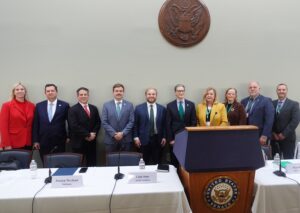State and Territorial Environmental Priorities for Economic Prosperity
March 26, 2025

The National Governors Association (NGA) and the Environmental Council of the States (ECOS) held a Congressional briefing to highlight the critical role of state and territorial governments in environmental protection and economic development—and the importance of a close partnership with the federal government. The briefing served to underscore Governors’ priorities for the 119th U.S. Congress, especially environmental issues, including clean water, permitting reform, and ensuring federal funding commitments. Providing the state and territorial perspective were:
- Cody Sims, Director of Federal Affairs, Office of South Carolina Governor Henry McMaster, Co-Chair of NGA Economic Development and Revitalization Task Force
- Myra Reece, ECOS Past President and Interim Director, South Carolina Department of Environmental Services
- Preston Weyland, Deputy Director of Federal Affairs, Office of Michigan Governor Gretchen Whitmer on behalf of the NGA Economic Development and Revitalization Task Force
- Amanda LeFevre, Deputy Commissioner, Kentucky Department of Environmental Protection
- Terry Gray, ECOS At-Large Member and Director, Rhode Island Department of Environmental Management
- Jess Byrne, Environmental Research Institute of the States President and Director, Idaho Department of Environmental Quality
- Geoff Smith, Federal Affairs, Office of NGA Vice Chair Oklahoma Governor Kevin Stitt.
“Governors are committed partners to ensuring strong water infrastructure, addressing the impact of forever chemicals, and pursuing creative permitting reform at the state level. Together, these policies improve the environment, public health, local economies and United States global competitiveness. However, their success relies on continued partnership from Congress and the administration. Our goal today is simple: to leave you with a clear picture of the situation on the ground as Governors and other state leaders implement federal priorities and policies, [to] highlight what’s going right and to identify areas where Congress can act to help states and territories have the resources and authority needed to achieve shared goals.”
– Tiffany Waddell, Director of Government Relations, NGA

Cody Sims opened the discussion by presenting environmental priorities identified by the NGA Economic Development Task Force, including investing in water resources and clean water, accelerating infrastructure project delivery and streamlining permitting, and ensuring federal funding commitments are honored. He reminded congressional staff that Governors are on the frontlines of ensuring that people have clean drinking water, and he emphasized the importance of Clean Water and Drinking Water State Revolving Funds (SRF) in achieving that goal. Governors are asking Congress to maintain consistent funding for SRFs, to ensure that the successful state and federal partnership continues to meet long-term needs for our water system. He noted that Governors are leading efforts to support communities impacted by PFAS, stressing there’s an economic impact, particularly among farmers, in addition to the health impact. On accelerating infrastructure development and permitting, Sims reminded attendees that this is a big, and bipartisan, priority of Governors, and that work occurring at the state level can help inform federal reforms. He continued by pointing out the importance of ensuring that federal funding commitments are honored both for economic development and energy grid stability. Sims closed by saying that Governor McMaster always reminds people that economic development and environmental policies are mutually supporting, not conflicting, goals.

Myra Reece continued this theme, emphasizing the importance of a healthy environment for a healthy economy, one example being cleaning up contaminated sites and returning them to the community. She said that South Carolina is focused on modernizing environmental protection and building state capacity. Reece reminded attendees that over 90% of environmental programs are implemented by states, and that environmental issues are not getting simpler. This increased complexity requires a well-informed workforce, with recruitment and retention becoming more expensive even while federal funding has declined or remained level over the last 20 years. She concluded by saying that there are opportunities for efficiency and productivity gains, particularly with AI systems coming online, and accelerating the circular economy.
Preston Weyland opened his remarks by saying Michigan is a very water centric state, with the Great Lakes having a large economic footprint, not just for the state, but all of America. Because of this, Michigan has been a leader on water infrastructure with lead service line replacements and other projects. Weyland then talked about the importance of SRFs and problems caused by diverting funds away from these programs to finance earmarks. He noted that Michigan alone has lost around $50 million for the SRFs in recent years. Governors sent a letter on this concern in September 2023, and NGA has published additional background information and impact data from Fiscal Year (FY) 2024.
Amanda LeFevre continued the conversation by noting that: “Infrastructure is the life and health of our community, not only for public health and environmental health, but the economic health of our community. Without clean drinking water, without adequate water and wastewater capacity to attract businesses, without tools for community redevelopment, and without adequate and robust energy, we have challenges.” Given this reality, LeFevre concluded that a fully funded SRF program to support growth and provide clean water is paramount, along with developing the workforce to build and maintain these systems.
Continuing the funding discussion, Terry Gray from Rhode Island discussed the importance of state and tribal assistance grants (STAG grants) in environmental protection. STAG grants are essential for core program work in clean air, clean water, and waste management, the three pillars of traditional environmental protection that make a difference in quality of life for everyone in the country. Gray said that these programs are the steady foundation on which the bulk of states’ work is built, and it’s very important to maintain them. Unfortunately, STAG grants have been stagnant for years, and there is a need for inflation adjustments to maintain their effectiveness. Gray closed by also noting the importance of workforce development in the environmental protection world, using the management of bio solids in Rhode Island as an example of the need for reliable, experienced professionals.
Deep into the briefing, Rick Kessler got in the weeds discussing Maryland’s comprehensive approach to dealing with PFAS and biosolids. Regarding PFAS, he argued for the need for regional solutions and federal assistance in research and mitigation. In support of Terry Gray, Kessler also emphasized that buying power of federal grants has eroded over the years, and that more money is needed to promote innovation and explore upstream solutions.
Jess Byrne continued the discussion by identifying barriers to project delivery, noting that while a lack of resources is often the largest barrier, “resources” does not just mean funding; states are also challenged by staffing and technical expertise. “In Idaho, we take our responsibility to protect the environment and carry out that part of our mission very seriously,” Byrne said. “But we also take our responsibility to help enable economic development very seriously, and so we’re always trying to figure out ways that we can streamline our permitting processes and provide better services. However, today, we find ourselves in a very challenging situation, and it really is due to a lot of the recruitment and retention challenges we’re experiencing as an organization.” Byrne supported this point with staffing statistics from the Idaho Department of Environmental Quality and pointed out that recruitment and retention not only affects environmental programs, but permitting as well, with the time to deliver air quality construction permits doubling over the past four years due to staffing challenges. He discussed Idaho’s efforts, including utilizing contractors and streamlining permitting processes, to address these challenges and detailed support the federal government can provide in funding workforce development and providing flexibility in program delivery.
Geoff Smith, from NGA Vice Chair Oklahoma Governor Kevin Stitt’s office, discussed the formation of NGA’s permitting reform working group. The working group will identify best practices and highlight Governors’ efforts to improve permitting and infrastructure delivery. The goal is to minimize permitting delays and improve economic development and national security, while preserving environmental safeguards. Smith noted that permitting reform is a bipartisan priority, and “the bottom line is it really shouldn’t take longer to approve a project than it does to actually build the project. Democrats and Republicans alike recognize that permitting delays are really just weakening us as a country, weakening our economic growth, our security and our competitiveness…Governors from both sides of the aisle are really well-positioned to lean into this and to find great solutions for our country.”
After their remarks, panelists held a discussion with attendees on innovative approaches states and territories are taking to address environmental challenges and improve infrastructure delivery. Governors and other state leaders look forward to continuing and improving the successful partnership between states and the federal government in ensuring that the American people have reliable and resilient systems that promote safe communities and strong economic growth.
Search
RECENT PRESS RELEASES
Related Post




